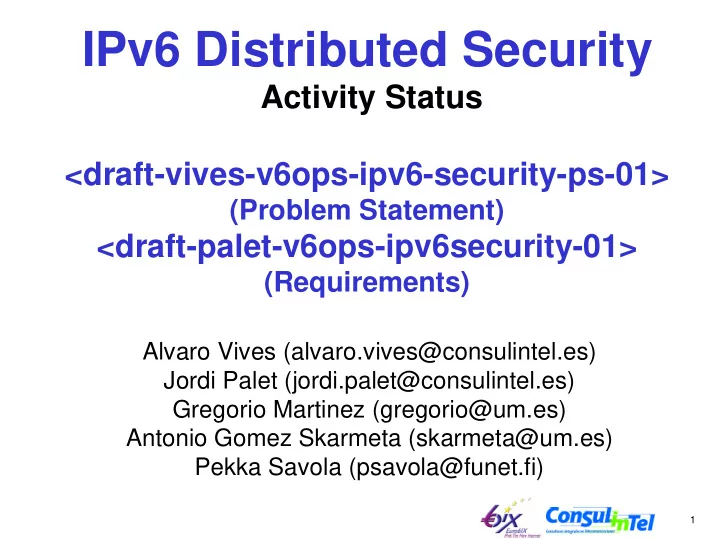

IPv6 Distributed Security Activity Status <draft-vives-v6ops-ipv6-security-ps-01> (Problem Statement) <draft-palet-v6ops-ipv6security-01> (Requirements) Alvaro Vives (alvaro.vives@consulintel.es) Jordi Palet (jordi.palet@consulintel.es) Gregorio Martinez (gregorio@um.es) Antonio Gomez Skarmeta (skarmeta@um.es) Pekka Savola (psavola@funet.fi) 1
Motivation • How would the deployment of IPv6 affect the security of a network? • IPv6 enabled devices and networks bring some issues to be taken into account by security administrators: – End-2-end communications – IPsec in all IPv6 stacks – Increased number of IP devices – Increased number of “nomadic” devices • Identify IPv6 Issues that justify the need of a new security model 2
Network-based Security Model (I) CLIENTS I NTERNET SERVERS THREAT Sec. Policy 1 Sec. Policy 2 Policy Enforcement Point (PEP) 3
Network-based Security Model (II) • Main Assumptions: – Threats come from “outside” – Protected nodes won’t go “outside” – No backdoors (ADSL, WLAN, etc.) • Main Drawbacks: – Centralized model – Do not address threats coming from inside – FW usually acts as NAT/Proxy – Special solutions are needed for Transport Mode Secured Communications 4
Host-based Security Model (I) CLIENTS I NTERNET Policy Decision Point (PDP) ALERT SERVERS DEFAULT TRUST ON SEC. POLICY THREAT Sec. Policy 1 Sec. Policy 2 Policy Enforcement Point (PEP) 5
Host-based Security Model (II) HOME HOT-SPOT I NTERNET ALERT Policy Decision OFFICE DEFAULT Point (PDP) TRUST ON SEC. POLICY THREAT Sec. Policy 1 Sec. Policy 2 Policy Enforcement Point (PEP) 6
Host-based Security Model (III) • BASIC IDEA : Security Policy centrally defined and distributed to PEPs. The network entities will authenticate themselves in order to be trusted. • THREE elements: – Policy Specification Language – Policy Exchange Protocol – Authentication of Entities 7
Host-based Security Model (IV) • Main Assumptions : – Threats come from anywhere in the network – Each host can be uniquely and securely identified – Security could be applied in one or more of the following layers: network, transport and application • Main Drawbacks : – Complexity – Uniqueness and secured identification of hosts is not trivial – Policy updates have to be accomplished in an efficient manner – A compromised host still is a problem • But “isolating” it could be a solution 8
Host-based Security Model (V) • Main Advantages: – Protects against internal attacks – Don’t depend on where the host is connected – Still maintain the centralized control – Enables the end-2-end communication model, both secured or not – Better decision could be taken based on host-specific info. – Enables a better collection of audit info 9
IPv6 Issues (I) 1. End-2-end – Any host must be reachable from anywhere. NAT/Proxy is not desired. 2. Encrypted Traffic – For example IPsec ESP Transport Mode Traffic 3. Mobility – Both Mobile IP and the increase of “portable” IP devices will mean they will be in “out-of-control” networks 4. Addresses – Much more addresses -> hosts with more than one – Randomly generated addresses – Link-local Addresses 10
IPv6 Issues (II) 5. Neighbor Discovery – RA, RS, NA, NS and Redirect Messages could be used in a malicious way -> SEND 6. Embedded Devices – Number of devices with almost no resources to perform security tasks -> should be taken into account in a possible solution 11
Requirements towards a Solution • Dynamic security policy specification language, exchange protocol and server • Authentication of entities • Support of SEND protocol • Support for unmanaged nodes/devices • Control and node/network partition mechanism – Securization of the rest of the network in case of a thread, even if internal • Alert/notification mechanism – Facilitate the inter-node and/or node-policy server communication • Node or host firewall, with a secure “default configuration”, that can be updated by a trusted dynamic security policy server. Should also include functionalities such as: – Integral thread protection – Resolution and arbitration of conflicts between different security policies – Support for end-to-end application level security (i.e., Web Services security standards) – Intrusion detection – Collection of audit information • Optionally it could also include: – Anti-virus – Anti-spam 12
Next Steps • Get inputs from the WG and security area • Continue the work – Solutions – Implementation – Trial in real networks, not just labs 13
14 Questions ? Thanks !
Recommend
More recommend